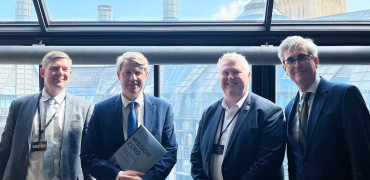Heating in the UK accounts for almost a third of all carbon emissions, so changing how we heat our buildings is critical if we are to achieve the UK’s net zero ambitions.
To do this, we must all shift away from our reliance on fossil fuels as the primary source of heating in both residential and commercial buildings, and this means embracing low-carbon technologies much more quickly than we currently are.
In particular we need to utilise technologies, such as heat pumps that efficiently use the UK’s growing supply of renewably-generated electricity.
Heat pumps are a proven and efficient technology, suitable for a wide range of applications, and available to be deployed at a mass scale today.
Designers will also have to re-think their approaches to heating and hot water in buildings
The UK Heat & Building Strategy
The four nations in the UK, England, Wales, Scotland and Northern Ireland, are all on the same journey, though each is taking slightly different approaches.
The government has put in place various proposals across the UK to make net-zero a reality, and it’s important to understand that the strategies being implemented can encourage a change in our heating habits in both new and existing buildings.
In 2019, the UK government became the first major economy in the world to set an objective of achieving net-zero greenhouse gas emissions by 2050 - and to enshrine that goal in law. Getting to this goal by 2050 requires changes to be made across the UK economy, from transport to agriculture to manufacturing – and one of the essential aspects is decarbonising our buildings.
There are around 30 million buildings in the UK which are responsible for 30% of national emissions, and 79% of building emissions come from heating. In October 2021, the UK Heat and Buildings Strategy was published to outline how the country might tackle this challenge, and it highlights several crucial points about the future of heat in UK buildings. These include moving away from burning fossil fuels, making buildings more efficient through improvements like insulation, and embracing heat pumps and heat networks for heat and hot water.
Different policies
While the whole of the UK is on the same path to achieving net-zero, and all countries recognise decarbonising heating as a major step to success, there are different policies and strategies being considered and applied in each area – depending on the current energy landscape.
In England, one of the biggest challenges to decarbonisation is persuading householders to switch from gas to alternatives like heat pumps. 88% of the total homes in England rely on gas for heating and hot water – so moving to heat pumps is a big change.
The UK government has set aside £12 billion through the Help to Heat programme to encourage this move. This includes the Boiler Upgrade Scheme, which provides grants to property owners to install low-carbon heating systems. For commercial buildings, the future of heating is likely to be further influenced by the Future Building Standard, which the government intends to introduce in 2025.
Scotland aims to install zero-emissions heating systems in over a million homes by 2030, and another 50,000 non-domestic buildings will convert to zero-emissions heating systems. The Scottish Parliament has also committed “at least £1.8 billion” to support heat and energy efficiency projects across Scotland to help boost the energy efficiency sector.
The Welsh government has set progressively higher targets for greenhouse gas emissions cuts since 2016. The challenge for Wales is that it has some of the UK’s oldest and least thermally efficient housing stock. Around 30% of houses were built before 1919, and just 10% of homes in Wales have been built since 2020. One of the main focuses is therefore promoting affordable energy-efficient heating and offering financial support to local authorities and registered social landlords across Wales.
In Northern Ireland, targets have gone beyond the earlier recommendation of an 82% reduction to aiming for net-zero emissions by 2050 – and therefore faces a significant challenge in achieving its objective in a shorter time than its other UK counterparts.
In contrast to England, few homes in Northern Ireland are connected to a gas grid, and around 68% are reliant on oil for heating and hot water. In addition, 72% of the population uses open fires with coal or peat as secondary heat sources. Their goal is that by 2028, all heating appliances being installed should be zero carbon in properties off the gas grid and by 2033 for those in the gas grid.
Decarbonising heat
To help achieve these ambitious targets, heat pumps and heat networks are vital technologies. As local authorities, designers and installers become more involved in applying low-carbon heating; it is also important to bear in mind that there are practical considerations when selecting these systems, which can vary depending on the application.
For domestic installations, for example, it is vital that a home is suitable for a low-temperature heat pump system, and homes constructed from 2024 must be designed for low-temperature heating systems at 55°C.
Fabric efficiency levels are also higher than under previous regulations. When retrofitting heat pumps into existing homes, it’s crucial to consider insulation levels and ensure that these are adequate before replacing an existing gas or oil boiler.
Heat networks are also considered an essential technology for the future of heat in UK buildings. In the past, heat networks, which supply heat from a central source to multiple buildings, used large gas boilers or combined heat and power equipment as the primary heat source. However, this is changing as modern system designers look to use more renewable and recovered sources of heat energy, which can include local water sources such as rivers and lakes or heat pumps.
One modern approach to using low-carbon heat sources is the ambient heat loop. With this method, network temperatures are low, between 10°C and 30°C. An ambient energy loop in place of an energy centre pushes energy into the network. Water is pumped around the loop and used as a heat source or a heat sink by heat pumps in each building or apartment on the network.
The important consideration for designers is that the ambient loop approach must focus on balancing the system temperature. Where heat is taken from the loop, it must also be added elsewhere. While this creates its own design challenges, the benefit is that the loop can use heat rejected elsewhere.
In summary
The future of heat in buildings across the UK looks very different from current approaches, and there is undoubtedly a significant challenge ahead in moving the UK away from its reliance on fossil fuels to low-carbon technologies. There is also the added challenge of addressing different needs and landscapes across areas of the UK – and varying plans in place.
To help achieve net-zero across the whole UK, installers will need to be trained to work with and maintain both domestic and commercial heat pumps. Designers will also have to re-think their approaches to heating and hot water in buildings, and heat network development will require a multi-building approach.
New and existing developments in heating technologies offer an exciting opportunity to decarbonise heating across the UK. New ways of thinking can be a challenge, but they are needed in order to move in the right direction to a low-carbon future.
Harvey Loyal, Market and Product Intelligence Specialist




